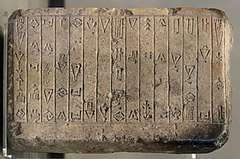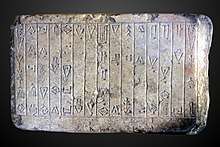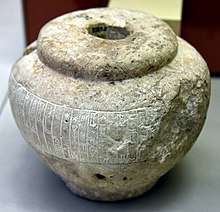Gutian dynasty of Sumer
The Gutian dynasty, also Kuti or Kutians (Sumerian: 𒄖𒋾𒌝𒆠, gu-ti-umKI) was a dynasty that came to power in Mesopotamia c. 2199—2119 BC (middle), or possibly c. 2135—2055 BC (short), after displacing the Akkadian Empire. It ruled for roughly one century; however, some copies of the Sumerian King List (SKL) vary between 4 and 25 years. The end of the Gutian dynasty is marked by the accession of Ur-Nammu (founder of the Third Dynasty of Ur, which fl. c. 2112 BC (middle) or 2055 BC (short)).
Gutian Dynasty of Sumer | |||||||||
|---|---|---|---|---|---|---|---|---|---|
| circa 2199–2119 BC (middle) | |||||||||
 The Gutians attacking a Babylonian city, as Akkadians are making a stand outside their city. 19th century illustration. | |||||||||
| Capital | Akkad | ||||||||
| Common languages | Gutian language and Sumerian language | ||||||||
| Government | Monarchy | ||||||||
| énsí | |||||||||
• fl. c. 2135—2129 BC (short) | Inkishush (first) | ||||||||
• fl. c. 2055—2055 BC (short) | Tirigan (last) | ||||||||
| Historical era | Bronze Age | ||||||||
• Established | circa 2199 | ||||||||
• Disestablished | 2119 BC (middle) | ||||||||
| |||||||||
| Today part of | |||||||||
The Gutian people (Guti) were native to Gutium, presumably in the central Zagros Mountains, though almost nothing is known about their origin.
History
The Gutians were described as part of the horde that toppled the kingdom of Akkad (or Agade).[1] It was a conglomeration of tribes that descended from the Zagros Mountains, possibly drawn to the plains for its prosperity.[1] The ancient Mesopotamians treated them as subnormal beings for their unwillingness to conform to customs and laws of civilization. Chronicles written around the end of the third millennium BC, for instance, described the Gutians as barbarians, having the intelligence of dogs and the appearance of monkeys while speaking a language similar to a confused babble.[2]
The Gutians practiced hit-and-run tactics, and would be long gone by the time regular troops could arrive to deal with the situation. Their raids crippled the economy of Sumer. Travel became unsafe, as did work in the fields, resulting in famine.
The Sumerian king list indicates that king Ur-Utu of Uruk was defeated by the barbarian Guti, perhaps around 2150 BC. The Guti swept down, defeated the demoralized Akkadian army, took Akkad, and destroyed it around 2115 BC. However, they did not supplant all of Akkad, as several independent city-states remained alongside them, including Lagash, where a local dynasty still thrived and left numerous textual and archaeological remains.[3] The first Guti ruler was a nameless king.
Ultimately Akkad was so thoroughly destroyed that its site is still not known. The Guti proved to be poor rulers.[4] Under their crude rule, prosperity declined. They were too unaccustomed to the complexities of civilization to organize matters properly, particularly in connection with the canal network. This was allowed to sink into disrepair, with famine and death resulting. Thus, a short "dark age" swept over Mesopotamia.[4]
Akkad bore the brunt of this as the center of the Empire, so that it was in Akkad that the Guti established their own center in place of the destroyed Akkad.[4] Some of the Sumerian cities in the south took advantage of the distance and purchased a certain amount of self-government by paying tribute to the new rulers.[4]
Uruk was thus able to develop a fifth dynasty. Even in the city of Akkad itself, a local dynasty was said to have ruled.[5] The best known Sumerian ruler of the Gutian period was the ensi of Lagash, Gudea. Under him, c. 2075 BC (short), Lagash had a golden age, and seemed to enjoy a high level of independence from the Gutians.[4]
After a few kings, the Gutian rulers became more cultured. Guti rule lasted only about a century — around 2050 BC, they were expelled from Mesopotamia by a coalition of rulers of Uruk and Ur[1], when Utu-hengal of Uruk defeated Gutian king Tirigan:[4]
"By the envoys of Utu-hengal, Tirigan and his wife and children in Dabrum were captured. They placed fetters on his handsand put a cloth (blindfold) over his eyes. Utuḫegal before Utu made him lie at his (Utu’s) feet, and on his neck he set his foot. Gutium, the fanged snake of the mountain ranges, he made drink from the cracks in the earth."
Utu-hengal's victory revived the political and economic life of southern Sumer.[4] The year 11 of king Ur-Nammu also mentions "Year Gutium was destroyed".[9]
Weidner Chronicle
1,500 years later, the Weidner Chronicle (ABC 19) accounts for the Gutian period as follows:
Naram-Sin destroyed the people of Babylon, so twice Marduk summoned the forces of Gutium against him. Marduk gave his kingship to the Gutian force. The Gutians were unhappy people unaware how to revere the gods, ignorant of the right cultic practices. Utu-hengal, the fisherman, caught a fish at the edge of the sea for an offering. That fish should not be offered to another god until it had been offered to Marduk, but the Gutians took the boiled fish from his hand before it was offered, so by his august command, Marduk removed the Gutian force from the rule of his land and gave it to Utu-hengal.
There are scholars who state that the description of the Gutian rule over parts of Mesopotamia was fiction or that it at least gave undue importance to the Guti horde. This is believed to be perpetuated by the chroniclers of Uruk to turn Utu-hegal's minor victory into an event of universal significance for the purpose of solidifying support for his emergent regime.[2] This view is based on the varying accounts of the surviving manuscripts, with many of them in total disagreement as to the length of the king's reign and even the identities of the Guti kings.[2]
List of Gutian kings
According to the SKL:
In the army of Gutium, at first no king was famous; they were their own kings and ruled thus for 3 years.
Gutian kings not on the SKL
| Ruler | Epithet | Length of reign | Approximate dates (short) | Comments |
|---|---|---|---|---|
| Erridupizir | 3 years | fl. c. 2141—2138 BC | Known from a royal inscription at Nippur. | |
| Imta or Nibia | 3 years | fl. c. 2138—2135 BC | ||
Gutian kings on the SKL
The listed reign lengths throughout much of the Gutian period are comparatively short and uniform:
| Ruler | Epithet | Length of reign | Approximate dates (short) | Comments |
|---|---|---|---|---|
| Inkishush or Inkicuc | 6 years | fl. c. 2135—2129 BC | First Gutian ruler named on the SKL. | |
| Sarlagab or Zarlagab | 6 years | fl. c. 2129—2123 BC | Possibly the same person as the Gutian king Sharlag (who was captured by the Akkadian king Shar-kali-sharri). | |
| Shulme | 6 years | fl. c. 2123—2117 BC | ||
| Elulmesh or Elulumesh | 6 years | fl. c. 2117—2111 BC | Possibly the same person as Elulu (who contended for power following the Akkadian king Shar-kali-sharri's death). | |
| Inimabakesh | 5 years | fl. c. 2111—2106 BC | ||
| Igeshaush | 6 years | fl. c. 2106—2100 BC | ||
| Yarlagab | 5 years | fl. c. 2100—2095 BC | ||
| Ibate | 3 years | fl. c. 2095—2092 BC | ||
| Yarla or Yarlangab | 3 years | fl. c. 2092—2089 BC | ||
| Kurum | 3 years | fl. c. 2089—2086 BC | ||
| Apilkin | 3 years | fl. c. 2086—2083 BC | ||
| La-erabum or Lasirab | 2 years | fl. c. 2083—2081 BC | Known from a mace head inscription. | |
| Irarum | 2 years | fl. c. 2081—2079 BC | ||
| Ibranum | 1 year | fl. c. 2079—2078 BC | ||
| Hablum | 2 years | fl. c. 2078—2076 BC | ||
| Puzur-Suen | 7 years | fl. c. 2076—2069 BC | the son of Hablum | |
| Yarlaganda | 7 years | fl. c. 2069—2062 BC | Known from a foundation inscription at Umma. | |
| Si'um or Si'u |  |
7 years | fl. c. 2062—2055 BC | Known from a foundation inscription of Lugalannatum at Umma. |
| Tirigan | 40 days | fl. c. 2055—2055 BC | Defeated by the Uruk king Utu-hengal. | |
Modern connection theories
The historical Guti have been regarded by many scholars as having contributed to the ethnogenesis of the Kurds.[10][11][12][13][14][15] However, Kurds are an Iranian people,[16] and the first known Indo-Iranians in the region were the Mitanni, who established a kingdom in northern Syria five centuries after the fall of Gutium.[17] The Mitanni are believed to have spoken an Indo-Aryan language,[18] or perhaps a pre-split Indo-Iranian language.[19][20] The current view is that the separation of Iranian peoples from Indo-Aryans occurred between 1800 and 1600 BCE, which makes it nearly impossible for the Gutians to have been linguistically or culturally Kurdish, although it is possible that they still contributed to an extent, if at the very least genetically.
According to Tamaz V. Gamkrelidze and Vyacheslav V. Ivanov, the Gutian language was close to the Tocharian languages of the Indo-European family.[21]
See also
Notes and references
Part of a series on the |
|---|
| History of Iraq |
.jpg) |
|
|
|
|
- Crawford, Harriet (2004). Sumer and the Sumerians, Second Edition. Cambridge, UK: Cambridge University Press. pp. 21, 22. ISBN 0-521-53338-4.
- Glassner, Jean-Jacques (2004). Mesopotamian Chronicles. Atlanta: Society of Biblical Lit. pp. 97, 98. ISBN 1-58983-090-3.
- De Mieroop, Marc Van. (2004). A History of the Ancient Near East: c. 3000-323 BC. (pp.67) Malden, MA: Blackwell Publishing.
- Corporation, Marshall Cavendish (2010). Ancient Egypt and the Near East: An Illustrated History. Marshall Cavendish. p. 54–56. ISBN 978-0-7614-7934-5.
- De Mieroop, Marc Van. (2004). A History of the Ancient Near East: c. 3000-323 BC. (p.67) Malden, MA: Blackwell Publishing.
- Full transcription and translation in: "CDLI-Found Texts". cdli.ucla.edu.
- THUREAU-DANGIN, Fr. (1912). "La Fin de la Domination Gutienne". Revue d'Assyriologie et d'archéologie orientale. 9 (3): 111–120. ISSN 0373-6032. JSTOR 23283609.
- The Sumerian Kings List (PDF). p. 119, note 305.
- "Year names of Ur-Nammu". cdli.ucla.edu.
- Omran Yahya Feili; Arlene R. Fromchuck (1986). Michael Curtis (ed.). The Middle East Reader. Transaction Books. p. 123. ISBN 9781412837798.
- Jamie Stokes, ed. (2009). "Kurds". Encyclopedia of the Peoples of Africa and the Middle East. Facts on File. p. 380.
- William Linn Westermann (1944). Peoples of the Near East Without a National Future. Council on Foreign Relations. p. 8.
- D. P. Erdbrink (1968). "Reviewed Work: Türken, Kurden und Iraner seit dem Altertum by E. von Eickstedt". Central Asiatic Journal. Harrassowitz Verlag. 12 (1): 64–65. JSTOR 41926760.
- Prokhorov, Aleksandr Mikhaĭlovich (1982). "Great Soviet Encyclopedia".
- "Art and Archaeology". 1931.
- Izady, Mehrdad R. (1992). The Kurds: A Concise Handbook. Taylor & Francis. ISBN 978-0-8448-1727-9.
- M. Mayrhofer, Die Arier im Vorderen Orient – ein Mythos? Sitzungsberichte der Oesterreichischen Akademie der Wissenschaften 294,3, Vienna 1974; M. Mayrhofer, Etymologisches Wörterbuch des Altindoarischen, Heidelberg 1986–2000, vol. IV
- M. Mayrhofer, Die Arier im Vorderen Orient – ein Mythos? Sitzungsberichte der Oesterreichischen Akademie der Wissenschaften 294,3, Vienna 1974; M. Mayrhofer, Etymologisches Wörterbuch des Altindoarischen, Heidelberg 1986–2000, vol. IV
- Robert Drews, "The Coming of the Greeks: Indo-European Conquests in the Aegean and the Near East", Princeton University Press, Chariot Warfare. p. 61
- Annelies Kammenhuber, "Die Arier im vorderen Orient" (Heidelberg: Carl Winter Universistätsverlag, 1968. p. 238. On p. 238 she indicates they spoke a "noch ungeteiltes Indo-Iranisch".
- Гамкрелидзе Т. В., Иванов Вяч. Вс. Первые индоевропейцы на арене истории: прототохары в Передней Азии // Вестник древней истории. 1989. № 1.
- Howorth 1901: "The Early History of Babylonia", Henry H. Howorth, The English Historical Review, Vol. 16, No. 61 (Jan. 1901), p. 1-34

.jpg)


.jpg)
